Synthesis of 2-Ethylhexyl 5-Bromothiophene-2-Carboxylates; Antibacterial Activities against Salmonella Typhi, Validation via Docking Studies, Pharmacokinetics, and Structural Features Determination through DFT
Abstract
:1. Introduction
2. Results and Discussion
2.1. Chemistry
2.2. Antibacterial Activity of the Antibiotics and Compounds (4A–4G) against XDR S. Typhi
2.3. Structure–Activity Relationship (SAR)
- In this research, among the synthesized thiophenes, molecule 4F inhibited the clinical isolate XDR S. Typhi at an MIC 3.125 mg/mL.
- It is interesting to note that the remarkable antibacterial activity of 4F against XDR S. Typhi is due to the presence of dual thiophene moieties.
2.4. Theoretical Analysis
2.4.1. Molecular Docking Studies
2.4.2. Drug Likeness and Pharmacokinetics
2.5. DFT Studies
2.5.1. NMR Spectra
2.5.2. Frontier Molecular Orbital (FMO) Analysis
2.5.3. MESP
2.5.4. Conceptual DFT Reactivity Descriptors
3. Materials and Methods
3.1. Information on the Compounds
3.2. Synthesis of the 2-Ethylhexyl 5-Bromothiophene-2-Carboxylate (3)
3.3. Synthesis of Compounds 4A–4G
3.4. Characterization Data
3.5. Molecular Docking Studies
3.5.1. Methodology Section
3.5.2. Confirmation of the Isolates
3.5.3. Antimicrobial Susceptibility Testing of XDR S. Typhi
3.5.4. Agar Well Diffusion Assay of Molecules 4A–4G Compared to XDR S. Typhi Strain
3.5.5. Minimum Inhibitory Concentration of Molecules 4A–4G against XDR S. Typhi
3.5.6. Minimum Bactericidal Concentration of Compounds 4A–4G against XDR S. Typhi Strain
4. Conclusions
Supplementary Materials
Author Contributions
Funding
Institutional Review Board Statement
Informed Consent Statement
Data Availability Statement
Acknowledgments
Conflicts of Interest
References
- Rudd, K.E.; Johnson, S.C.; Agesa, K.M.; Shackelford, K.A.; Tsoi, D.; Kievlan, D.R.; Colombara, D.V.; Ikuta, K.S.; Kissoon, N.; Finfer, S. Global, regional, and national sepsis incidence and mortality, 1990–2017: Analysis for the Global Burden of Disease Study. Lancet 2020, 395, 200–211. [Google Scholar] [CrossRef]
- Nagshetty, K.; Channappa, S.T.; Gaddad, S.M. Antimicrobial susceptibility of Salmonella typhi in India. J. Infect. Dev. Ctries. 2010, 4, 070–073. [Google Scholar] [CrossRef]
- Fahlin, C. Trends in antibiotic resistance amongst pathogens causing enteric fever in India, Nepal and Pakistan 2012–2021. Bachelor’s Thesies, Örebro University, Örebro, Sweden, 2023. [Google Scholar]
- Joshi, R.J.; Dholariya, M.P.; Chothani, S.R.; Chirag, A.C.; Varu, H.L.; Karmur, M.B.; Maliwal, D.; Pissurlenkar, R.R.; Bapodra, A.H.; Patel, A.S. Synthesis, antidiabetic activity and in silico studies of benzo [b] thiophene based small molecule α-amylase inhibitors. J. Mol. Struct. 2024, 1312, 138570. [Google Scholar] [CrossRef]
- Almatari, A.S.; Saeed, A.; Abdel-Ghani, G.E.; Abdullah, M.M.; Al-Lohedan, H.A.; Abdel-Latif, E.; El-Demerdash, A. Synthesis of some novel thiophene analogues as potential anticancer agents. Chem. Biodivers. 2024, 2024, e202400313. [Google Scholar] [CrossRef]
- El-Helw, E.A.; Alzahrani, A.Y.; Ramadan, S.K. Synthesis and antimicrobial activity of thiophene-based heterocycles derived from thiophene-2-carbohydrazide. Future Med. Chem. 2024, 16, 439–451. [Google Scholar] [CrossRef]
- Mehdhar, F.S.; Saeed, A.; Abdel-Latif, E.; Abdel-Galil, E.; El-Rayyes, A.; Abdel-Ghani, G.E. Synthesis, Biological Evaluation, and Docking Study of a New Series of Thiophene Derivatives Based on 3-Oxobutanamidothiophene as an Anticancer Agent. ChemistrySelect 2024, 9, e202400579. [Google Scholar] [CrossRef]
- Popsavin, M.; Djokić, S.; Kovačević, I.; Stanisavljević, S.M.; Kojić, V.; Rodić, M.V.; Aleksić, L.; Kesić, J.; Zelenović, B.S.; Popsavin, V. Synthesis and biological activity of thiophene bioisosteres of natural styryl lactone goniofufurone and related compounds. Eur. J. Med. Chem. 2024, 269, 116340. [Google Scholar] [CrossRef]
- Yasuda, H.; Izumi, N.; Shimada, O.; Kobayakawa, T.; Nakanishi, M. The protective effect of tinoridine against carbon tetrachloride hepatotoxicity. Toxicol. Appl. Pharmacol. 1980, 52, 407–413. [Google Scholar] [CrossRef]
- Özcan, H.; Deliorman, A.; Zaim, Ö.; Tüzün, N.Ş. Furan and Thiophene Based Cycloheterophane Esters and Thioesters: Synthesis, Antimicrobial Activities, and DFT Calculations. ChemistrySelect 2023, 8, e202302095. [Google Scholar] [CrossRef]
- Musa, K.A.; Eriksson, L.A. Photochemical and photophysical properties, and photodegradation mechanism, of the non-steroid anti-inflammatory drug Flurbiprofen. J. Photochem. Photobiol. A Chem. 2009, 202, 48–56. [Google Scholar] [CrossRef]
- Moore, P.; Larson, D.; Otterness, I.; Weissman, A.; Kadin, S.; Sweeney, F.; Eskra, J.; Nagahisa, A.; Sakakibara, M.; Carty, T. Tenidap, a structurally novel drug for the treatment of arthritis: Antiinflammatory and analgesic properties. Inflamm. Res. 1996, 45, 54–61. [Google Scholar] [CrossRef] [PubMed]
- Bell, R.; Young, P.; Albert, D.; Lanni, C.; Summers, J.; Brooks, D.; Rubin, P.; Carter, G. The discovery and development of zileuton: An orally active 5-lipoxygenase inhibitor. Int. J. Immunopharmacol. 1992, 14, 505–510. [Google Scholar] [CrossRef] [PubMed]
- Anwer, K.E.; Sayed, G.H.; Kozakiewicz-Piekarz, A.; Ramadan, R.M. Novel annulated thiophene derivatives: Synthesis, spectroscopic, X-ray, Hirshfeld surface analysis, DFT, biological, cytotoxic and molecular docking studies. J. Mol. Struct. 2023, 1276, 134798. [Google Scholar] [CrossRef]
- Li, L.; Hui, T.; Li, Y.; Wang, Y.; Gu, H.; Chen, G.; Lei, P.; Gao, Y.; Feng, J. Design, synthesis and antifungal activity of novel α-methylene-γ-butyrolactone derivatives containing benzothiophene moiety. Pest Manag. Sci. 2024. [Google Scholar] [CrossRef] [PubMed]
- Harit, T.; Bellaouchi, R.; Asehraou, A.; Rahal, M.; Bouabdallah, I.; Malek, F. Synthesis, characterization, antimicrobial activity and theoretical studies of new thiophene-based tripodal ligands. J. Mol. Struct. 2017, 1133, 74–79. [Google Scholar] [CrossRef]
- Coskun, D.; Gur, S.; Coskun, M.F. Synthesis, characterization and antimicrobial activity of novel benzofuran-and thiophene-containing diketoxime derivatives. J. Serbian Chem. Soc. 2017, 82, 367–377. [Google Scholar] [CrossRef]
- Ikram, H.M.; Rasool, N.; Zubair, M.; Khan, K.M.; Abbas Chotana, G.; Akhtar, M.N.; Abu, N.; Alitheen, N.B.; Elgorban, A.M.; Rana, U.A. Efficient double suzuki cross-coupling reactions of 2, 5-dibromo-3-hexylthiophene: Anti-tumor, haemolytic, anti-thrombolytic and biofilm inhibition studies. Molecules 2016, 21, 977. [Google Scholar] [CrossRef]
- Ikram, H.M.; Rasool, N.; Ahmad, G.; Chotana, G.A.; Musharraf, S.G.; Zubair, M.; Rana, U.A.; Zia-Ul-Haq, M.; Jaafar, H.Z. Selective C-arylation of 2, 5-dibromo-3-hexylthiophene via suzuki cross coupling reaction and their pharmacological aspects. Molecules 2015, 20, 5202–5214. [Google Scholar] [CrossRef]
- Pinheiro, P.F.; Martins, G.S.; Gonçalves, P.M.; Vasconcelos, L.C.; dos Santos Bergamin, A.; Scotá, M.B.; Santo, I.S.R.; Pereira, U.A.; Praça-Fontes, M.M. Phytocytogenotoxicity of Esters obtained from Phenols and Phenoxyacetic Acid using the Steglich reaction. Preprint 2024. [Google Scholar] [CrossRef]
- Hassner, A.; Alexanian, V. Direct room temperature esterification of carboxylic acids. Tetrahedron Lett. 1978, 19, 4475–4478. [Google Scholar] [CrossRef]
- Raza Shah, A.; Rasool, N.; Bılal, M.; Mubarık, A.; Alı Hashmı, M.; Nadeem Akhtar, M.; Imran, M.; Ahmad, G.; Siddiqa, A.; Adnan Alı Shah, S. Efficient Synthesis of 4-Bromo-N-(1-phenylethyl) benzamide, Arylation by Pd (0) Catalyst, Characterization and DFT Study. ChemistrySelect 2022, 7, e202200861. [Google Scholar] [CrossRef]
- Baell, J.B.; Holloway, G.A. New substructure filters for removal of pan assay interference compounds (PAINS) from screening libraries and for their exclusion in bioassays. J. Med. Chem. 2010, 53, 2719–2740. [Google Scholar] [CrossRef] [PubMed]
- Lipinski, C.A. Lead-and drug-like compounds: The rule-of-five revolution. Drug Discov. Today Technol. 2004, 1, 337–341. [Google Scholar] [CrossRef]
- Prasanna, S.; Doerksen, R. Topological polar surface area: A useful descriptor in 2D-QSAR. Curr. Med. Chem. 2009, 16, 21–41. [Google Scholar] [CrossRef] [PubMed]
- Omoregie, H.O.; Oloba-Whenu, O.A.; Olowu, O.J.; Fasina, T.M.; Friedrich, A.; Haehnel, M.; Marder, T.B. Mixed-ligand complexes of copper (ii) with thienoyltrifluoroacetonate and nitrogen containing ligands: Synthesis, structures, antimicrobial activity, cytotoxicity, Hirshfeld surface analysis and DFT studies. RSC Adv. 2022, 12, 23513–23526. [Google Scholar] [CrossRef]
- Adolphs, J.; Renger, T. How proteins trigger excitation energy transfer in the FMO complex of green sulfur bacteria. Biophys. J. 2006, 91, 2778–2797. [Google Scholar] [CrossRef]
- Akram, S.J.; Hadia, N.; Shawky, A.M.; Iqbal, J.; Khan, M.I.; Alatawi, N.S.; Ibrahim, M.A.; Ans, M.; Khera, R.A. Designing of Thiophene [3, 2-b] Pyrrole Ring-Based NFAs for High-Performance Electron Transport Materials: A DFT Study. ACS Omega 2023, 8, 11118–11137. [Google Scholar] [CrossRef] [PubMed]
- Schnuerch, M.; Haemmerle, J.; Mihovilovic, M.D.; Stanetty, P. A Systematic Study of Suzuki-Miyaura Cross-Coupling Reactions on Thiazoleboronic Esters in the 4-and 5-Position. Synthesis 2010, 2010, 837–843. [Google Scholar] [CrossRef]
- Arai, N.; Miyaoku, T.; Teruya, S.; Mori, A. Synthesis of thiophene derivatives via palladium-catalyzed coupling reactions. Tetrahedron Lett. 2008, 49, 1000–1003. [Google Scholar] [CrossRef]
- Sachdeva, E.; Kaur, G.; Tiwari, P.; Gupta, D.; Singh, T.P.; Ethayathulla, A.S.; Kaur, P. The pivot point arginines identified in the β-pinwheel structure of C-terminal domain from salmonella Typhi DNA gyrase A subunit. Sci. Rep. 2020, 10, 7817. [Google Scholar] [CrossRef]
- Ameji, P.; Uzairu, A.; Shallangwa, A.; Uba, S. Molecular docking study and insilico design of novel drug candidates against Salmonella typhi. Adv. J. Chem.-Sect. B 2022, 4, 281–298. [Google Scholar]
- Taye, B.; Giday, M.; Animut, A.; Seid, J. Antibacterial activities of selected medicinal plants in traditional treatment of human wounds in Ethiopia. Asian Pac. J. Trop. Biomed. 2011, 1, 370–375. [Google Scholar] [CrossRef] [PubMed]
- Spooner, D.; Sykes, G. Chapter IV Laboratory assessment of antibacterial activity. In Methods in Microbiology; Elsevier: Amsterdam, The Netherlands, 1972; Volume 7, pp. 211–276. [Google Scholar]
- Molla, Y.; Nedi, T.; Tadesse, G.; Alemayehu, H.; Shibeshi, W. Evaluation of the in vitro antibacterial activity of the solvent fractions of the leaves of Rhamnus prinoides L’Herit (Rhamnaceae) against pathogenic bacteria. BMC Complement. Altern. Med. 2016, 16, 287. [Google Scholar] [CrossRef]
- Chung, K.T.; Thomasson, W.; Wu-Yuan, C.D. Growth inhibition of selected food-borne bacteria, particularly Listeria monocytogenes, by plant extracts. J. Appl. Microbiol. 1990, 69, 498–503. [Google Scholar] [CrossRef] [PubMed]
- Joshi, B.; Lekhak, S.; Sharma, A. Antibacterial property of different medicinal plants: Ocimum sanctum, Cinnamomum zeylanicum, Xanthoxylum armatum and Origanum majorana. Kathmandu Univ. J. Sci. Eng. Technol. 2009, v.5, 143–150. [Google Scholar] [CrossRef]
- Janovska, D.; Kubikova, K.; Kokoška, L. Screening for antimicrobial activity of some medicinal plants species of traditional Chinese medicine. Czech J. Food Sci. 2003, 21, 107. [Google Scholar] [CrossRef]
- Shah, R.; Verma, P.K. Therapeutic importance of synthetic thiophene. Chem. Cent. J. 2018, 12, 137. [Google Scholar] [CrossRef]
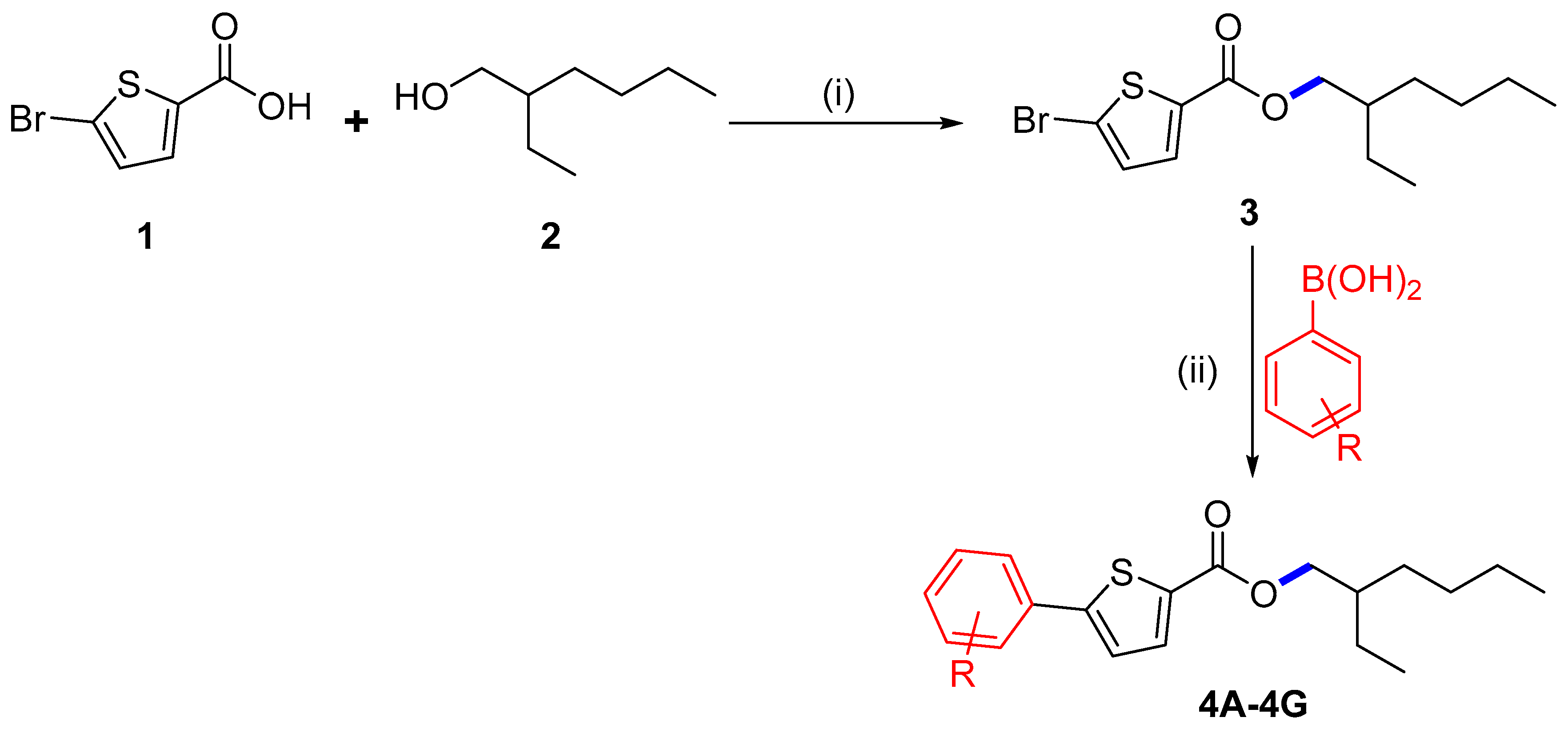
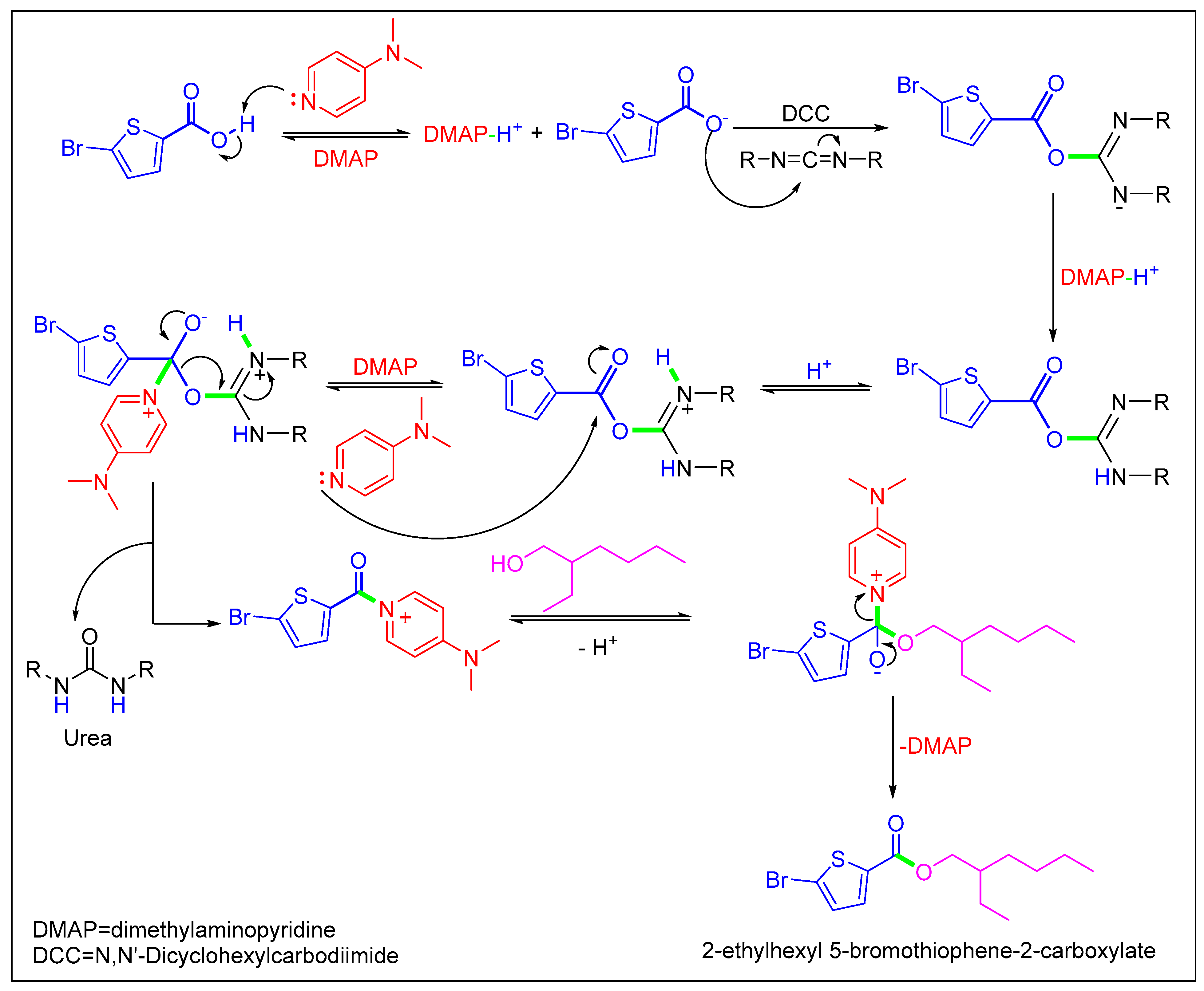
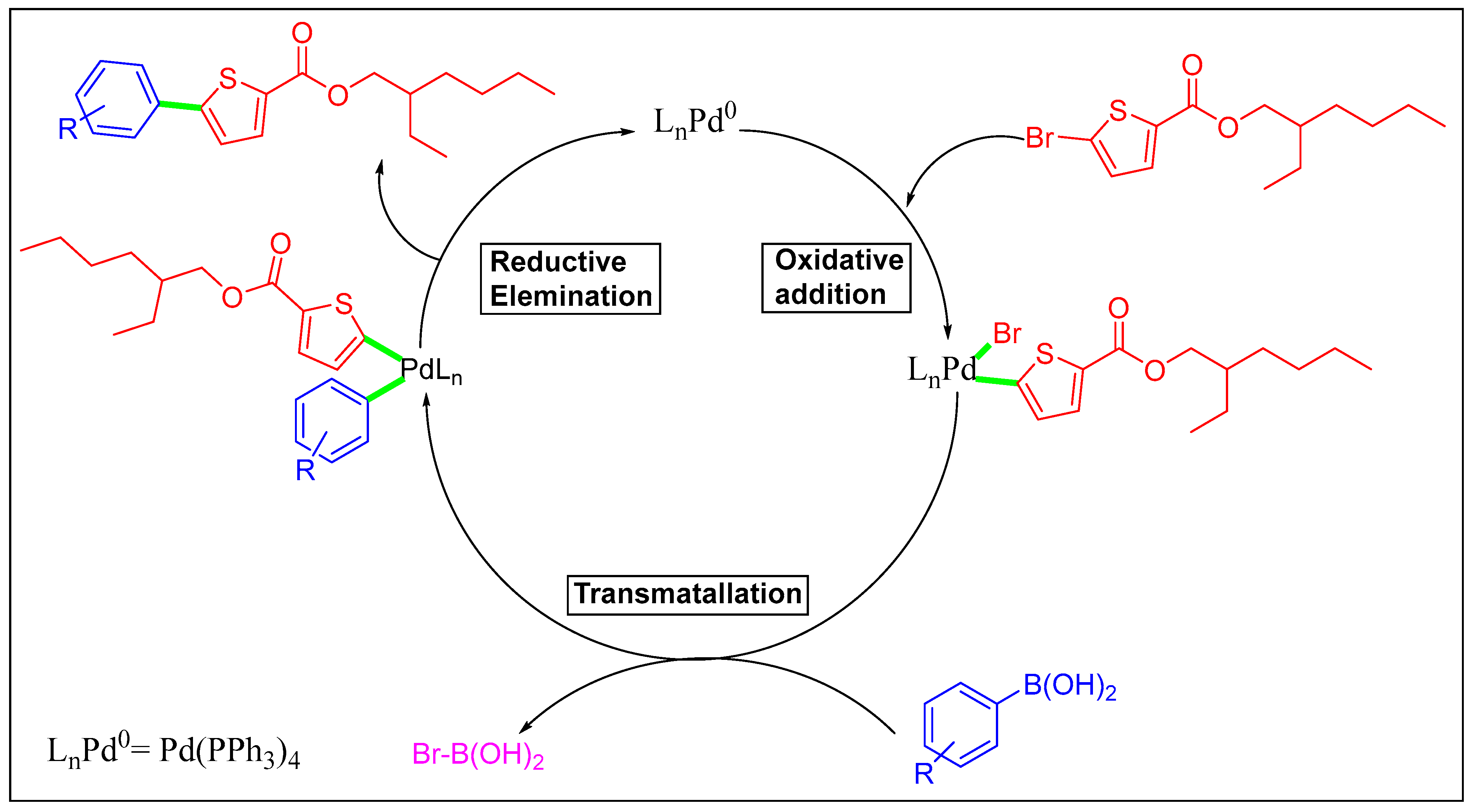


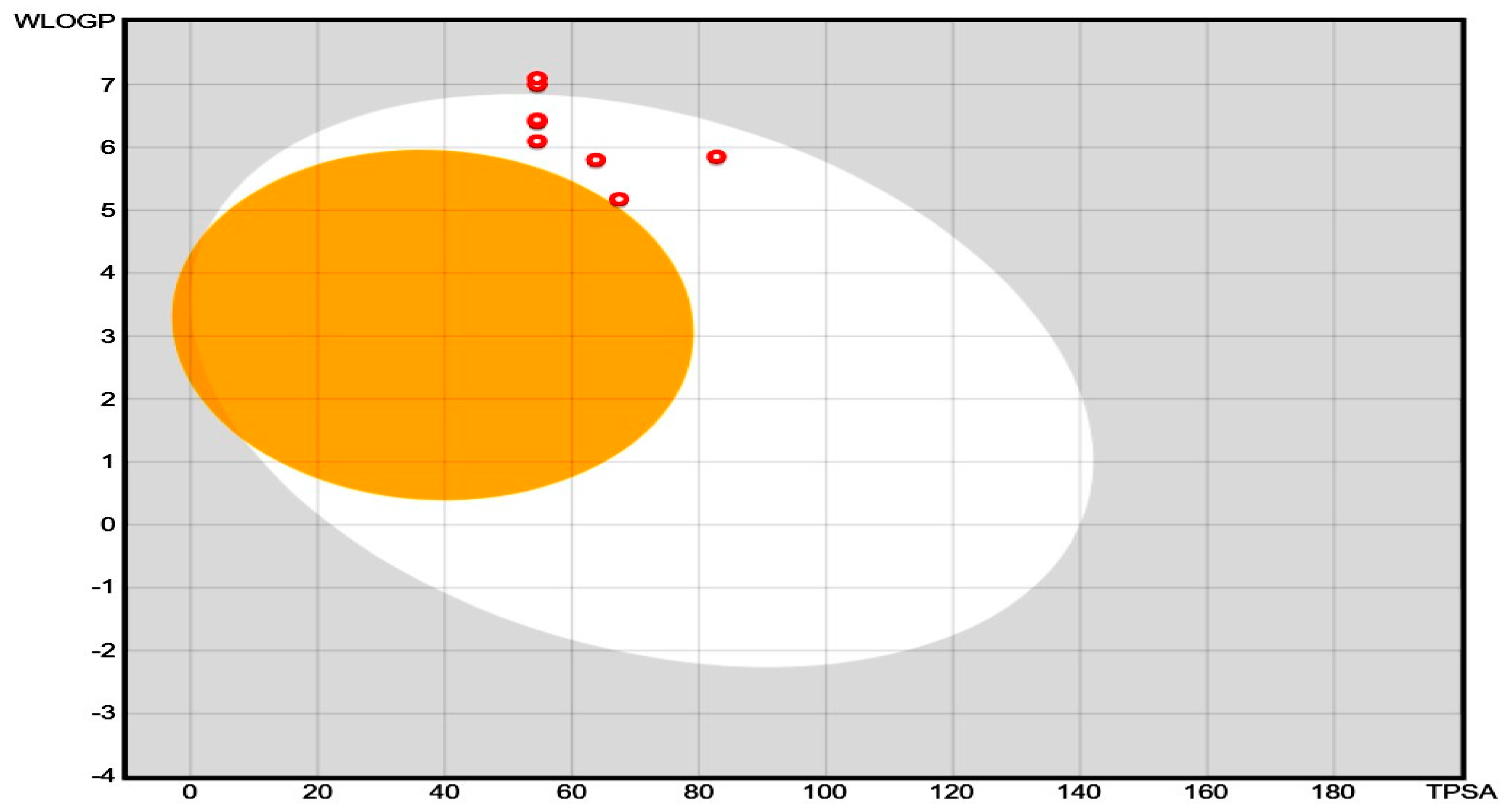
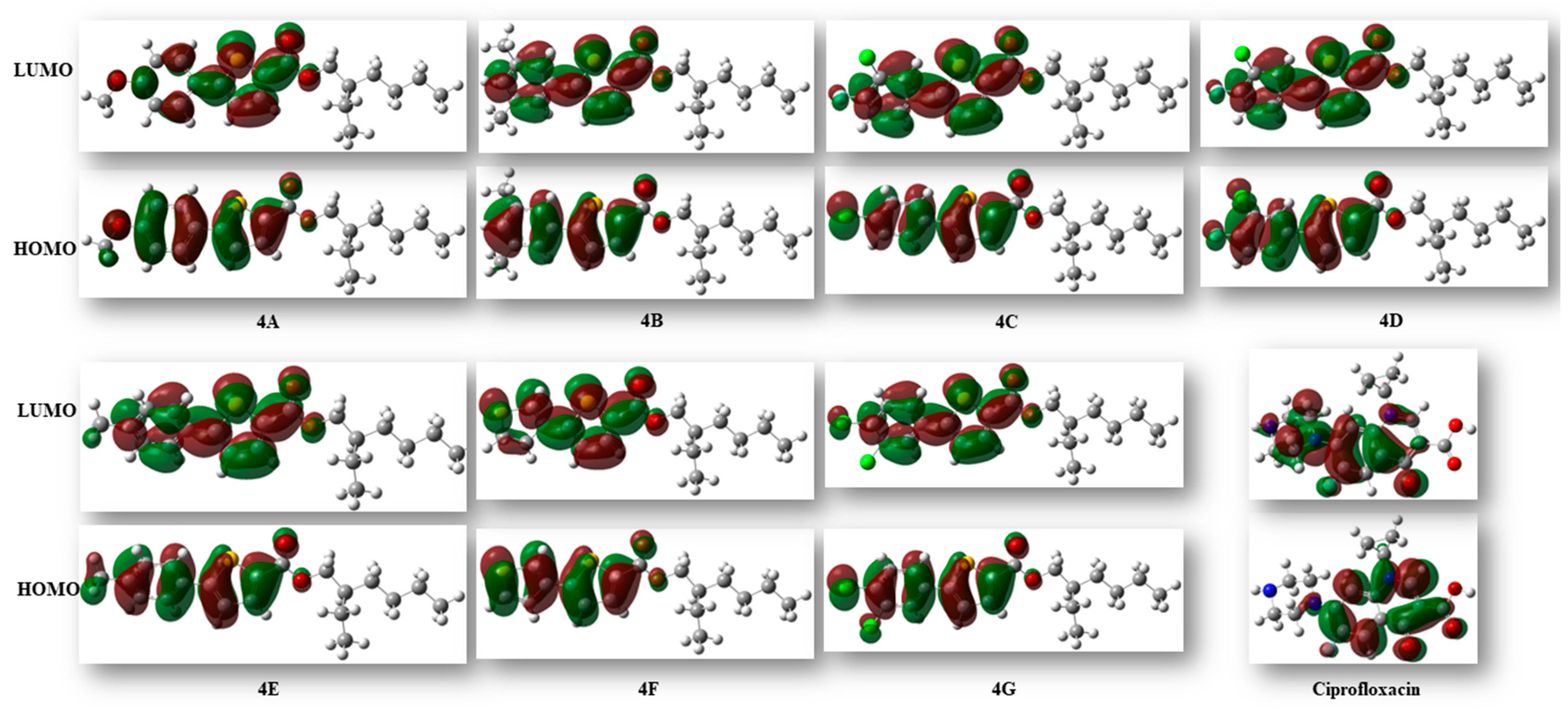

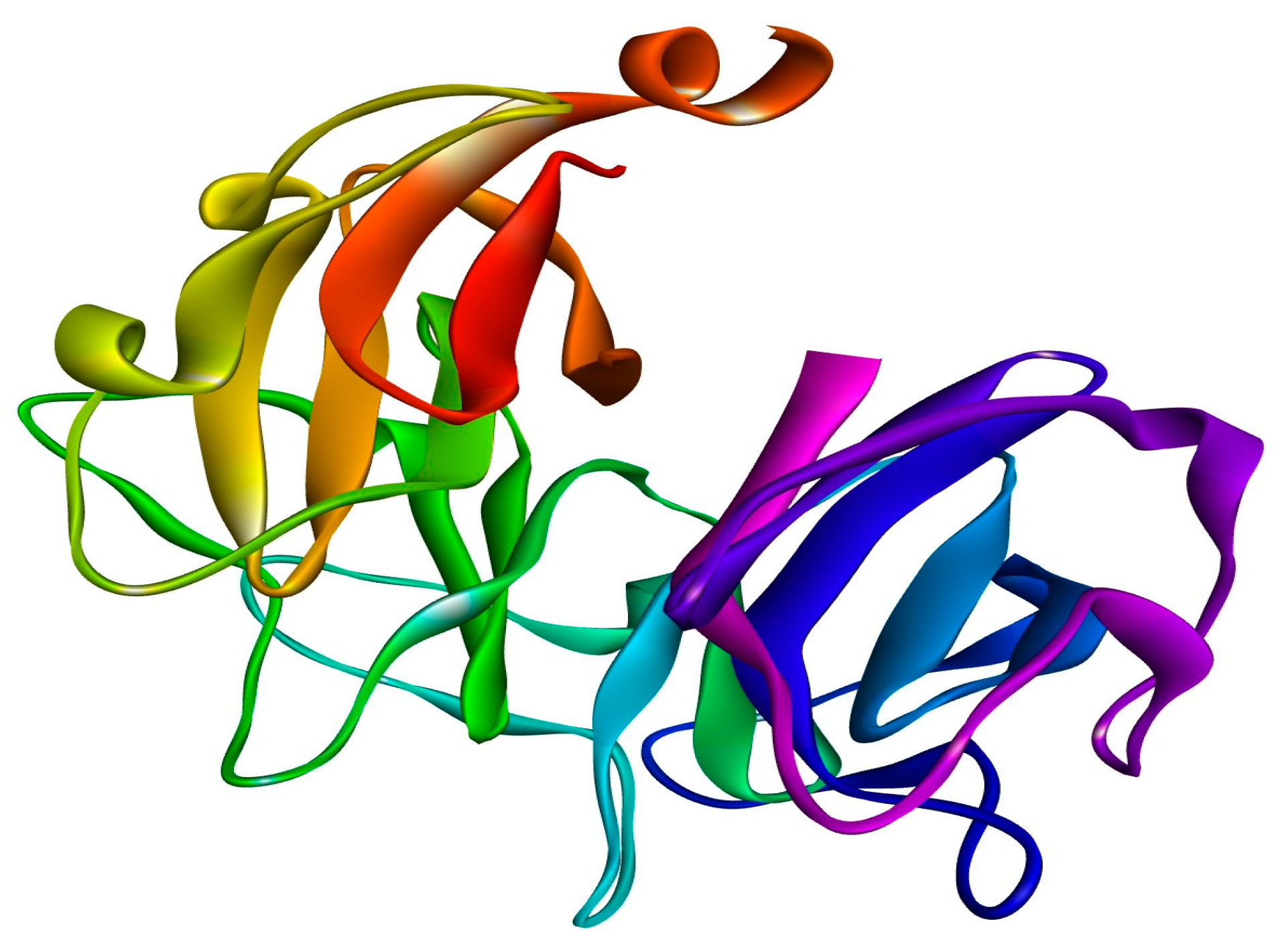
| Entry | Aryl Boronic Acid | Product | Solvent | Yield |
|---|---|---|---|---|
| 4A | 4-MeOC6H4B(OH)2 |  | 1,4-dioxane | 79% |
| 4B | 3,5-Me2C6H3B(OH)2 |  | 1,4-dioxane | 74% |
| 4C | 4-ClC6H4B(OH)2 |  | 1,4-dioxane | 65% |
| 4D | 3-Cl,4-FC6H3B(OH)2 |  | 1,4-dioxane | 60% |
| 4E | 4-MeC6H4B(OH)2 |  | 1,4-dioxane | 72% |
| 4F | C4H3B(OH)2S |  | 1,4-dioxane | 69% |
| 4G | 3,4-Cl2C6H3B(OH)2 |  | 1,4-dioxane | 62% |
| Entry No. | MIC (mg/mL) | MBC (mg/mL) | Ciprofloxacin (µg/mL) | Ceftriaxone (µg/mL) |
|---|---|---|---|---|
| 4A | 12.5 | 25 | ≥1 | ≥4 |
| 4B | 25 | 50 | ≥1 | ≥4 |
| 4C | 3.125 | 6.25 | ≥1 | ≥4 |
| 4D | 12.5 | 25 | ≥1 | ≥4 |
| 4E | 6.25 | 12.5 | ≥1 | ≥4 |
| 4F | 3.125 | 6.25 | ≥1 | ≥4 |
| 4G | 25 | 50 | ≥1 | ≥4 |
| Entry No. | Zone mm (50 mg) | Zone mm (40 mg) | Zone mm (30 mg) | Zone mm (20 mg) | Zone mm (10 mg) | Ciprofloxacin (5 µg) | Ceftriaxone (30 µg) |
|---|---|---|---|---|---|---|---|
| 4A | 17 | 13 | 12 | 12 | 11 | <20 | <19 |
| 4B | 4 | 4 | 4 | 4 | 4 | <20 | <19 |
| 4C | 15 | 15 | 13 | 12 | 11 | <20 | <19 |
| 4D | 16 | 15 | 13 | 12 | 11 | <20 | <19 |
| 4E | 4 | 4 | 4 | 4 | 4 | <20 | <19 |
| 4F | 25 | 23 | 23 | 21 | 23 | <20 | <19 |
| 4G | 12 | 10 | 10 | 10 | 18 | <20 | <19 |
| Compound | Interactions | Free Energy ΔG (KCal/mole) |
|---|---|---|
| 4A | H bonding: Lys550 C–H interaction: Arg612 π–σ interaction: Arg615 Alkyl and π-alkyl interaction: Tyr548, Ile578, Val839 | −6.23269 |
| 4B | H bonding: Lys550 C–H interaction: Arg612 Alkyl and π-alkyl interaction: Val540, Tyr548, Tyr557, Ile578 | −6.99511 |
| 4C | H bonding: Lys550 Alkyl and π-alkyl interaction: Ile578, Arg612, Arg615, Val839 | −5.93047 |
| 4D | H bonding: Lys550, Asp576 C–H interaction: Thr542 π–anion interaction: Asp576 Amide-π stacked: Gly613 Alkyl and π-alkyl interaction: Tyr557, Ile578, Val839 | −7.12247 |
| 4E | H bonding: Lys550 C–H interaction: Arg612 π–anion interaction: Asp576 Alkyl and π-alkyl interaction: Arg615, Val839 | −6.11878 |
| 4F | H bonding: Lys550, Arg612 π-sulfur: Tyr548 Alkyl and π-alkyl interaction: Ile578, Leu581, Arg615, Val839 | −7.38549 |
| 4G | H bonding: Gln560 C–H interaction: Lys550 Amide-π stacked: Gly613 Alkyl and π-alkyl interaction: Tyr548, Ile578, Arg612, Val839 | −6.97763 |
| Ciprofloxacin | H bonding: Lys550, Arg612, Gly613 C–H interaction: Tyr557, Asp576, Arg615 Alkyl and π-alkyl interaction: Ile578, Arg615 | −5.61799 |
| Code | TPSA a | Lipinski Violation | PAINS b | MLOGP c | NRB d | HBD e | GI Absorption f | HBA g |
|---|---|---|---|---|---|---|---|---|
| 4A | 63.77 | 0 | 0 | 4.80 | 10 | 0 | High | 3 |
| 4B | 54.54 | 0 | 0 | 4.41 | 9 | 0 | High | 2 |
| 4C | 54.54 | 0 | 0 | 4.44 | 9 | 0 | High | 2 |
| 4D | 54.54 | 0 | 0 | 4.42 | 9 | 0 | Low | 3 |
| 4E | 54.54 | 0 | 0 | 4.51 | 9 | 0 | High | 2 |
| 4F | 82.78 | 0 | 0 | 3.85 | 9 | 0 | High | 2 |
| 4G | 54.54 | 1 | 0 | 5.27 | 9 | 0 | Low | 2 |
| Compounds | EHOMO (eV) | ELUMO (eV) | Difference (eV) | Hyperpolarizability |
|---|---|---|---|---|
| 4A | −5.98 | −1.63 | 4.34 | 4644.46 |
| 4B | −6.33 | −1.71 | 4.61 | 1833.79 |
| 4C | −6.42 | −1.85 | 4.56 | 2566.26 |
| 4D | −6.55 | −1.85 | 4.69 | 1878.87 |
| 4E | −6.18 | −1.85 | 4.33 | 2379.28 |
| 4F | −6.25 | −1.67 | 4.57 | 2413.44 |
| 4G | −6.55 | −1.96 | 4.59 | 2184.60 |
| Ciprofloxacin | −5.98 | −1.18 | 4.80 | 2796.36 |
| Comp. No. | I (eV) | A (eV) | η (eV) | µ (eV) | ω (eV) |
|---|---|---|---|---|---|
| 4A | 5.98 | 1.63 | 2.17 | −3.81 | 3.34 |
| 4B | 6.33 | 1.71 | 2.30 | −4.02 | 3.51 |
| 4C | 6.42 | 1.85 | 2.28 | −4.13 | 3.74 |
| 4D | 6.55 | 1.85 | 2.34 | −4.20 | 3.76 |
| 4E | 6.18 | 1.85 | 2.16 | −4.02 | 3.73 |
| 4F | 6.25 | 1.67 | 2.28 | −3.96 | 3.43 |
| 4G | 6.55 | 1.96 | 2.29 | −4.26 | 3.95 |
Disclaimer/Publisher’s Note: The statements, opinions and data contained in all publications are solely those of the individual author(s) and contributor(s) and not of MDPI and/or the editor(s). MDPI and/or the editor(s) disclaim responsibility for any injury to people or property resulting from any ideas, methods, instructions or products referred to in the content. |
© 2024 by the authors. Licensee MDPI, Basel, Switzerland. This article is an open access article distributed under the terms and conditions of the Creative Commons Attribution (CC BY) license (https://creativecommons.org/licenses/by/4.0/).
Share and Cite
Nazeer, W.; Qamar, M.U.; Rasool, N.; Taibi, M.; Salamatullah, A.M. Synthesis of 2-Ethylhexyl 5-Bromothiophene-2-Carboxylates; Antibacterial Activities against Salmonella Typhi, Validation via Docking Studies, Pharmacokinetics, and Structural Features Determination through DFT. Molecules 2024, 29, 3005. https://doi.org/10.3390/molecules29133005
Nazeer W, Qamar MU, Rasool N, Taibi M, Salamatullah AM. Synthesis of 2-Ethylhexyl 5-Bromothiophene-2-Carboxylates; Antibacterial Activities against Salmonella Typhi, Validation via Docking Studies, Pharmacokinetics, and Structural Features Determination through DFT. Molecules. 2024; 29(13):3005. https://doi.org/10.3390/molecules29133005
Chicago/Turabian StyleNazeer, Waseem, Muhammad Usman Qamar, Nasir Rasool, Mohamed Taibi, and Ahmad Mohammad Salamatullah. 2024. "Synthesis of 2-Ethylhexyl 5-Bromothiophene-2-Carboxylates; Antibacterial Activities against Salmonella Typhi, Validation via Docking Studies, Pharmacokinetics, and Structural Features Determination through DFT" Molecules 29, no. 13: 3005. https://doi.org/10.3390/molecules29133005







